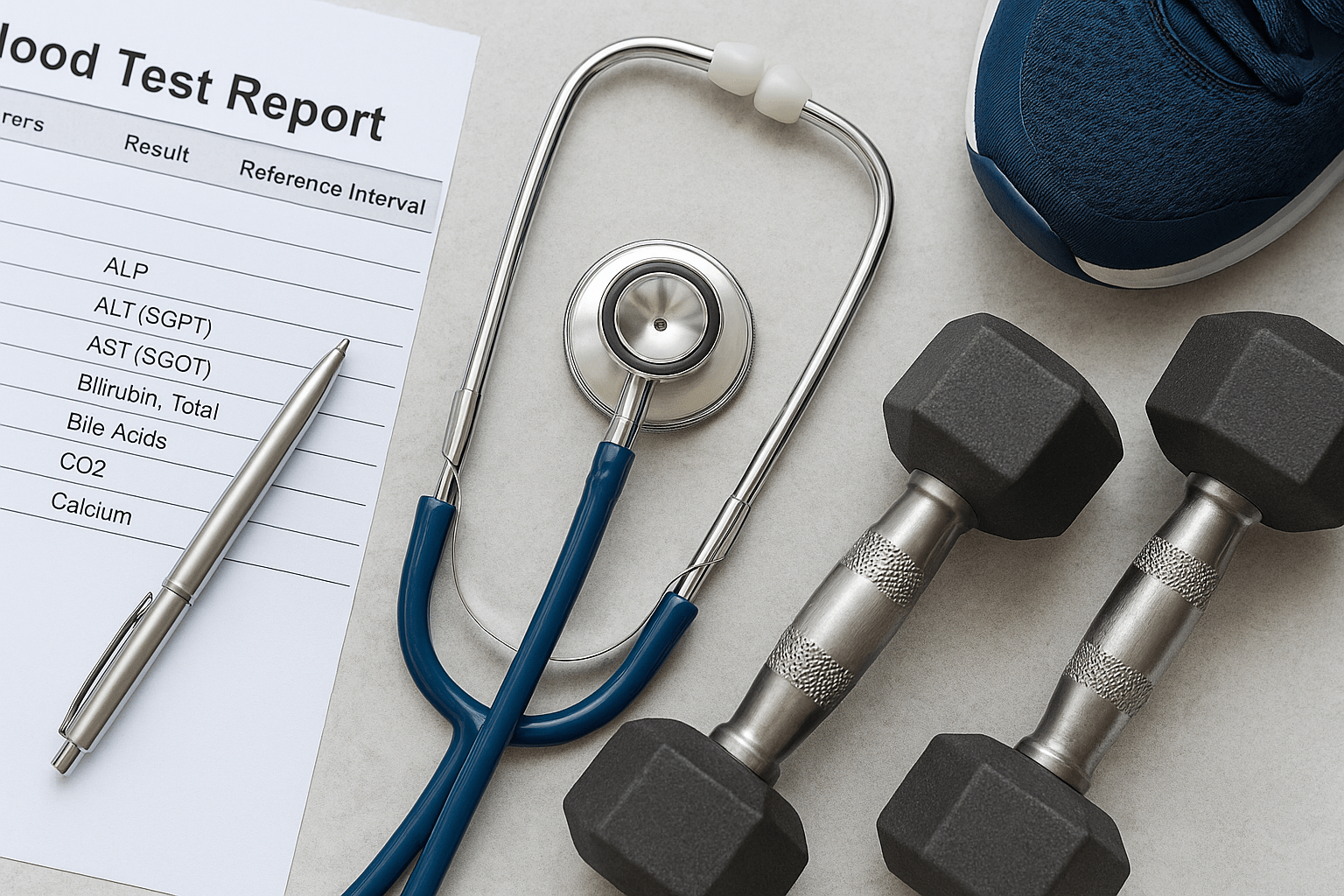How Does Exercise Affect Your AST Level? 5 Key Insights
If you’ve ever looked at a blood test after hitting the gym and noticed your AST levels were higher than normal, you might’ve felt a bit worried. It’s easy to assume something’s wrong with your liver, but that’s not always the case. Exercise affects AST level in ways that reflect how your muscles and liver respond to physical stress, not necessarily illness.
To understand why this happens, we need to look at what AST is, how it behaves during physical activity, and what those changes really mean for your health.
What Is AST and Why Does It Matter
AST stands for aspartate aminotransferase, an enzyme that helps your cells convert food into energy. It’s found mostly in your liver, heart, and muscles. Normally, only small amounts of AST circulate in your bloodstream. But when your liver or muscles experience strain, small amounts leak out, raising your levels temporarily.
Doctors often use AST readings to check liver function, but exercise can complicate things. Because your muscles also release AST, a rise in your test results doesn’t automatically mean liver trouble. Sometimes, it simply reflects how hard you’ve been working out.
How Exercise Changes AST Levels
When you exercise, your muscles undergo tiny amounts of stress. That stress causes microtears, small, harmless injuries that stimulate growth and repair. During this repair process, muscle cells release AST into the bloodstream.
Your liver joins in too, handling the increased energy demands from your workout. That extra workload can slightly elevate AST as well. These changes are part of how your body adapts, not a sign of damage.
With that in mind, here are five key insights that explain how exercise can influence AST levels and what to do about it.
1. AST Comes from Muscles Too
The first thing to understand is that the AST enzyme in muscles contributes a lot to what shows up in your blood test. During strenuous activity, such as heavy lifting, long-distance running, or intense interval training, your muscles break down and rebuild.
That process is perfectly normal. As the muscle fibres repair themselves, they release AST, which your test picks up. This is why someone who just started working out or returned after a break may see a temporary spike.
These rises are short-lived, usually returning to normal within a few days. Allowing proper rest, hydrating well, and eating nutrient-dense foods all help your body recover and bring your AST back down naturally.
2. Exercise and Liver Enzymes Are Closely Linked
Because AST is part of the liver enzyme panel, people often panic when they see an increase. But exercise and liver enzymes interact in complex ways. During workouts, your liver works harder to process nutrients, remove waste, and balance blood sugar. This added effort can temporarily raise AST and other enzymes like ALT (alanine aminotransferase).
Here’s the good news: in most cases, this increase isn’t harmful. In fact, long-term exercise helps your liver. Regular physical activity improves fat metabolism, reduces inflammation, and may even protect you from fatty liver disease. So while short-term AST changes may look alarming on paper, they often reflect a healthy, active metabolism rather than a medical problem.
3. Intensity and Duration Influence Your AST
Not all workouts affect your AST the same way. The harder or longer you push your body, the higher your levels may climb afterward. A gentle yoga class won’t have the same impact as a 10-mile run or a high-intensity gym session.
Below is a simple way to picture it:
Exercise Type | Typical AST Change | When Levels Normalize |
Light (walking, stretching) | Minimal | Within 24 hours |
Moderate (cycling, jogging) | Slight increase | 1–2 days |
Intense (HIIT, heavy lifting) | Noticeable rise | 2–4 days |
These numbers aren’t exact; they vary depending on your fitness level, hydration, and recovery habits. But the trend is consistent: the more intense the activity, the more your muscles release AST.
If you have a blood test scheduled, avoid tough workouts 24–48 hours beforehand to prevent skewed results.
4. Training Experience Matters
If you’re new to working out, you’ll probably notice bigger swings in your AST levels. That’s because your muscles aren’t used to the strain yet. As you keep training, your body adapts. Your tissues become stronger, recover faster, and release less AST with each session.
This is why seasoned athletes may train intensely without dramatic enzyme changes, while beginners see temporary spikes. It’s simply a reflection of conditioning. Over time, regular, balanced training teaches your body to handle stress efficiently, keeping AST levels more stable.
So if your numbers are higher after your first few weeks in the gym, don’t panic, it’s often a sign your body is adjusting.
5. When to Worry About High AST
While most exercise-related AST increases are harmless, there are times when it might indicate something more serious. If your levels stay elevated for more than several days, or if you feel unusually tired, sore, or weak, it’s time to pause and pay attention.
In rare situations, excessive exercise can lead to rhabdomyolysis, a condition where muscle tissue breaks down too quickly, flooding the bloodstream with enzymes and waste products. Symptoms can include dark urine, extreme muscle pain, or exhaustion. It’s uncommon, but if you experience those signs, you should contact a healthcare professional right away.
For most people, though, a temporary rise in AST simply means your body worked hard and is repairing itself.

Managing AST Levels and Supporting Recovery
Understanding how your AST reacts to workouts helps you train smarter, not harder. Here are some simple ways to keep your body balanced:
- Hydrate properly. Water supports circulation and helps clear waste from your muscles.
- Rest and recover. Give your body at least one rest day between tough workouts.
- Eat well. Include lean proteins, healthy fats, and antioxidant-rich foods to speed up repair.
- Avoid overtraining. More isn’t always better; balance effort with rest.
- Plan your lab tests wisely. Skip strenuous exercise before testing to get accurate readings.
A thoughtful approach to training not only helps your AST return to normal but also supports muscle recovery and AST balance, improving your overall energy and performance.
Understanding Transaminase Levels After a Workout
AST belongs to a group of enzymes called transaminases, which also includes ALT. These enzymes help process amino acids and are vital for energy production. So when you see changes in transaminase levels after workout sessions, it usually means your muscles are repairing and rebuilding themselves.
This temporary elevation is completely natural. Levels often return to normal within two to three days, depending on how intense your exercise was. Persistent high levels or ongoing fatigue may signal that your body needs more recovery time, or, less commonly, that something else is affecting your muscles or liver.
Tracking your AST trends over time is more useful than worrying about one test result. If you consistently notice high readings, bring them up with your healthcare provider, especially if they come with other symptoms.
Practical Takeaways
AST fluctuations tell a story about your body’s recovery and adaptation. Learning how to interpret that story helps you stay informed rather than anxious.
- Short-term AST increases are often linked to muscle recovery.
- Longer or harder workouts can temporarily raise levels more noticeably.
- Regular training reduces enzyme fluctuations as your body adapts.
- Hydration, nutrition, and rest all play roles in keeping AST balanced.
- Persistent or extreme elevations should be evaluated by a doctor.
In most cases, small changes mean your body is doing exactly what it should—responding to exercise and rebuilding stronger tissue.

Conclusion
Your body is constantly adjusting to physical challenges, and that includes how your exercise affects AST level readings. A small rise after a workout usually isn’t a warning sign; it’s your body’s way of showing that muscles are repairing and growing stronger.
With the right balance of movement, rest, and mindful recovery, you can keep your enzyme levels in a healthy range while improving overall strength and vitality.
If you want to take that balance even further and build a lifestyle that supports long-term health, explore our Longevity Program. It’s designed to help you create sustainable habits that enhance energy, recovery, and well-being for years to come.


